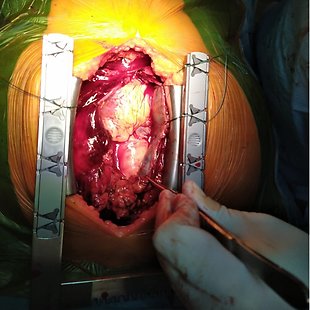Pericardial tamponade
Pericardial tamponade is a serious life-threatening condition whose early recognition is crucial for the patient. Therefore when an unfortunate accident happens, it is possible that even a traditional hunting session becomes a battle for life. Pericardial tamponade is one of the so-called "4T" reversible causes of sudden cardiac arrest, and in this algorithm we will guide you through its differential diagnosis and therapy, from prehospital care to definitive hospital treatment.
Review
Acute cardiac tamponade is in our country a relatively rare but potentially malignant diagnosis, which can be reversible with proper urgent diagnosis and therapy. It is one of the 4T, but we must think of it not only in the case of a sudden cardiac arrest, but also in all penetrating and blunt (non-penetrating) chest injuries and not only in them. Cardiac tamponade is a dynamic process that evolves in time and the algorithm correctly demonstrates the typical course from the possible cause, the onset of clinical symptoms to severe instability just before cardiac arrest. This is followed by proper diagnosis and therapy leading to stabilization and the recommendation of the aftercare. In individual parts of the algorithm, the whole problematics is summarized step by step, including other useful information. Incorrect answers demonstrate the most common mistakes and decision-making difficulties for this diagnosis. The algorithm correctly emphasizes the key importance of ultrasonography in early hospital care, but it can also be applied to pre-hospital care in case of the availability of ultrasound, which will (hopefully) be the standard in a few years. The mentioned algorithm is a valuable, clear and entertaining professional contribution to the reminder of one potentially reversible cause of a circulatory instability for traumas (or even of a sudden cardiac arrest), including its solution.
Sources
A. Linhart, P. Toušek, Summary of 2015 ESC Guidelines for the diagnosis and management of pericardial diseases. Prepared by the Czech Society of Cardiology, Cor et Vasa 58 (2016) e106–e126. Available at: https://www.sciencedirect.com/science/article/pii/S001086501600014X J.
Konečný, M. Šimek, A. Klváček, R. Hájek, J. Škorpil, P. Hubáček, V. Lonský. Penetrující poranění srdce- přehled. [online]. Kardiol Rev Int Med 2014. 16(6): 512–515. Available at: https://www.kardiologickarevue.cz/casopisy/kardiologicka-revue/2014-6/penetrujici-poraneni-srdce-prehled-50715
Urgentní medicína. Doporučené postupy pro resuscitaci ERC 2015: Souhrn doporučení. [online]. Praha: MEDIPRAX CB s.r.o., vol. 18 [cit. 30. 11. 2015]. ISSN 1212-1924. Available at: https://www.resuscitace.cz/ke-stazeni C. Lott, et al., European Resuscitation Council Guidelines 2021: Cardiac arrest in special





